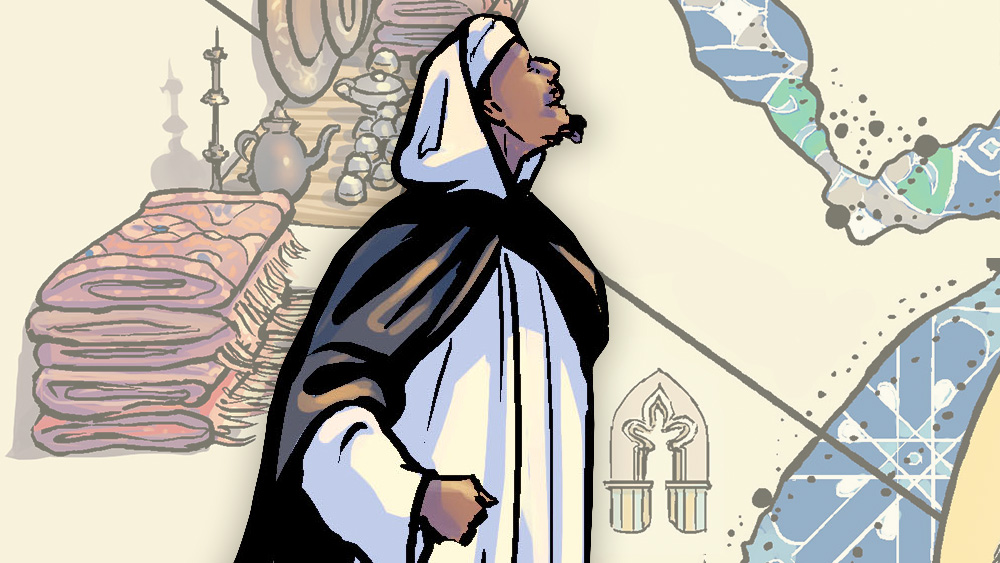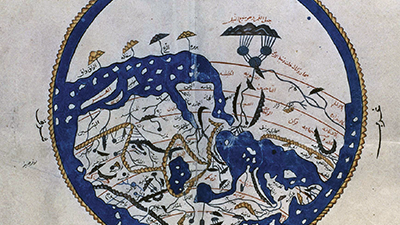Dar al-Islam
Teacher Resources
Driving Question: How did the spread of Islam influence human communities and networks in Afro-Eurasia during this period?
Dar al-Islam is Arabic for The House of Islam. It’s a way of describing the Islamic world—the vast regions controlled by Muslim rulers and linked by the Islamic faith. Stretching from West Africa to Indonesia, Dar al-Islam encompassed a vast array of cultures, languages, and traditions in this period, all connected by a shared Islamic culture.
Learning Objectives:
- Assess the role that the Islamic Golden Age played in Afro-Eurasian states and networks.
- Use the historical thinking practice of contextualization to assess how Mansa Musa was able to make his journey during this historical period.
- Use a graphic biography to support, extend, or challenge the overarching narratives of this period.
Vocab Terms:
- belief system
- contextualize
- maritime
- migration
- mosque
- prophet
- trade
Opener: Dar al-Islam
To teach this lesson step, refer to page 2 of the Lesson 2.3 Teaching Guide.
Looking for an at-a-glance explanation of how OER Project: World History approaches contextualization? Take a look at our one-pager on the topic.
Maps can help you understand how beliefs spread and change. Use this quick mapping activity to help guide you through the changes in this lesson.
Contextualizing History
To teach this lesson step, refer to page 3 of the Lesson 2.3 Teaching Guide.
Take a look at our claim testing one-pager if you’re looking for a quick refresher of this vital skill.
To see where we’re going, we have to remember where we’ve been. That might sound like something from a self-help book, but you’ll soon see why knowing the context for an event is so important.
The Golden Age of Islam
To teach this lesson step, refer to page 5 of the Lesson 2.3 Teaching Guide.
Want to know more about Islamic scholars from this time period? Take a look at what our Big History course has to offer on that topic.
A vast expanse of Afro-Eurasia was connected by the shared cultural and religious system of Islam. Even after empires declined, these cultural ties continued to thicken.
-
Guiding Questions
-
Before you read
Preview the questions below, and then skim the comic, paying attention to things like prominent colors, shapes, and types of text and fonts. How do you know where to start and in which direction to read? What’s in the gutters (the space between panels)? Who or what is the focus of the comic?
While you read
- Who was Ibn Battuta and why did he leave his home?
- How was Ibn Battuta able to support himself while he traveled?
- What do the quotes from Ibn Battuta’s writing tell you about his experiences while traveling?
- What does the story about Ibn Battua’s interactions with Al-Bushri tell you about the nature of Dar al-Islam during this period?
- How does the artist use art and design to demonstrate Islamic cultural connections during this period?
After you read
Respond to this question: How does this graphic biography of Ibn Battuta support, extend, or challenge what you have learned about the Islamic world?
-
Guiding Questions
-
Before you read
Preview the questions below, and then skim the article. Be sure to look at the section headings and any images.
While you read
Look for answers to these questions:
- What is Dar al-Islam?
- What were some of the cultural and technological innovations of Islamic scholars during this period?
- What were the effects of these innovations in Dar al-Islam?
- Islam experienced a political fragmentation while it also saw a cultural expansion. What does that mean?
- What does Ibn Battuta’s experience on his travels to tell us about Dar al-Islam?
After you read
Respond to this question: Does it make sense for historians to define a region based on a shared belief system rather than a single government? Why or why not?
The Crusades
To teach this lesson step, refer to page 6 of the Lesson 2.3 Teaching Guide.
How did centuries-long wars between Christians and Muslims lead to productive cultural and scientific exchange? It doesn’t seem like war would be great for intellectual reciprocity, but stranger things have happened.
-
Guiding Questions
-
Before you watch
Preview the questions below, and then review the transcript.
While you watch
Look for answers to these questions:
- Why did the Byzantine Emperor reach out to the pope for help? Why did the pope agree?
- Were the Crusades successful? How did they impact networks in the Mediterranean world?
- Which European powers benefited the most from the Crusades?
- What evidence do we have that the Crusades impacted both Christian and Islamic culture?
- How did the Crusades affect scholarship in Europe?
After you watch
Respond to the following questions:
- As a result of the Crusades, which societies were pushed further apart?
- Which societies became more connected?
Mansa Musa
To teach this lesson step, refer to page 7 of the Lesson 2.3 Teaching Guide.
Want to read about classes having fun with contextualization? Check out this conversation in the OER Project Teacher Community.
Did you know that the wealthiest person in world history lived in fourteenth-century West Africa? Learn how Mansa Musa embraced Islam and reshaped the economics of Afro-Eurasia.
-
Guiding Questions
-
Before you watch
Preview the questions below, and then review the transcript.
While you watch
Look for answers to these questions:
- Why are oral traditions important for understanding history?
- Who was Mansa Musa, and why was his hajj (pilgrimage to Mecca) so significant?
- What was Mali like when Mansa Musa ruled it, in terms of both politics and religion?
- What kinds of states were built along the eastern coast of Africa at this time, and how were they linked?
- What kinds of goods were traded through the Swahili city-states?
After you watch
Respond to the following questions:
- Why do you think two different kinds of states formed in different African regions (large empires in the interior of West Africa and city-states along the coast of East Africa)?
- How is Ibn Battuta’s life evidence of the Islamic World as a network?
Key Ideas
Closer: Dar al-Islam
To teach this lesson step, refer to page 12 of the Lesson 2.3 Teaching Guide.
Check out this tool to help students get the most out of reading graphic biographies.
Rumi wrote poetry and expressed his faith through mysticism and dancing. His teachings crossed borders and inspired people for centuries.







